At GPTPromptsHub, we understand the importance of continuous learning and skill improvement for developers. That’s why we’ve compiled a list of 100 amazing ChatGPT coding prompts that cater to various programming languages and use cases.
In this blog post, we’ll explore how coders can leverage ChatGPT to enhance their practical knowledge and learning. As experts in prompts and their use cases, our team is dedicated to providing authentic and helpful content to empower developers and programmers with ChatGPT.
12 Examples of Long-Form ChatGPT Coding Prompts for Various Languages
ChatGPT Prompts For Python Coders
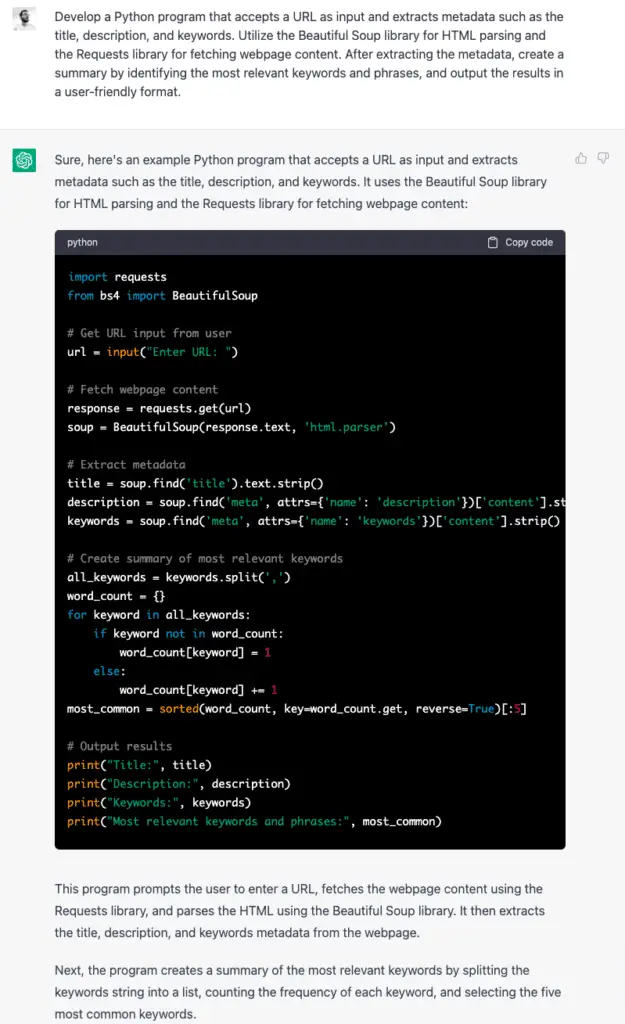
1. Develop a Python program that accepts a URL as input and extracts metadata such as the title, description, and keywords. Utilize the Beautiful Soup library for HTML parsing and the Requests library for fetching webpage content. After extracting the metadata, create a summary by identifying the most relevant keywords and phrases, and output the results in a user-friendly format.
2. Write a Python script that scrapes data from different websites, such as news articles, social media posts, or product listings. Use the Scrapy framework to create a robust and scalable web scraper that can navigate through multiple pages and extract relevant information. Store the collected data in a structured format like JSON or CSV for further analysis. 3. Design a Python-based weather forecasting application that utilizes a weather API like OpenWeatherMap to retrieve real-time weather data for a given location. Implement features such as current temperature, humidity, wind speed, and a 5-day forecast. Create a user-friendly command-line interface or a graphical user interface using Tkinter or PyQt5.
4. Build a Python script that automates email sending using the smtplib library. Allow users to input recipient email addresses, subject lines, and email content. Implement features like sending attachments, scheduling emails for future delivery, and sending bulk emails using CSV files for recipient data.
5. Develop a Python-based social media content scheduler that helps users automate posting across multiple platforms like Twitter, Instagram, and Facebook. Integrate relevant APIs for each platform and enable features like scheduling posts, uploading media, and analyzing post engagement.
6. Create a Python program for monitoring website uptime and performance. Allow users to input a list of websites, set monitoring intervals, and receive notifications via email or SMS when a website goes down or experiences performance issues.
7. Implement a Python-based inventory management system for small businesses. Incorporate features like product tracking, stock level alerts, sales data analysis, and customer information management. Utilize a database like SQLite for data storage and retrieval.
8. Develop a Python-based recommendation engine for movies or books using a dataset from sources like IMDb or Goodreads. Implement collaborative filtering or content-based filtering algorithms to generate personalized recommendations for users. Provide a user-friendly interface to browse, rate, and discover new content.
9. Create a Python program that analyzes social media sentiment for a specific topic or keyword using APIs from Twitter or Reddit. Implement natural language processing techniques using libraries like NLTK or spaCy to gauge sentiment polarity and visualize the results using charts and word clouds.
10. Build a Python-based optical character recognition (OCR) tool that extracts text from images or scanned documents. Utilize libraries like Tesseract or pytesseract for OCR functionality and OpenCV for image processing. Implement features like language detection, text rotation correction, and output formatting.
11. Design a Python program that automates data entry into web forms or desktop applications using libraries like Selenium WebDriver for web automation or Pywinauto for desktop automation. Implement features like input validation, error handling, and customizable input fields.
12. Create a Python-based machine learning model for predicting stock prices or market trends using historical financial data. Utilize libraries like Scikit-learn, TensorFlow, or PyTorch to train and evaluate the model, and provide a user-friendly interface for inputting data and visualizing predictions.
Check Out: Amazing ChatGPT Prompts For Engineering
ChatGPT Prompts For JavaScript Coders
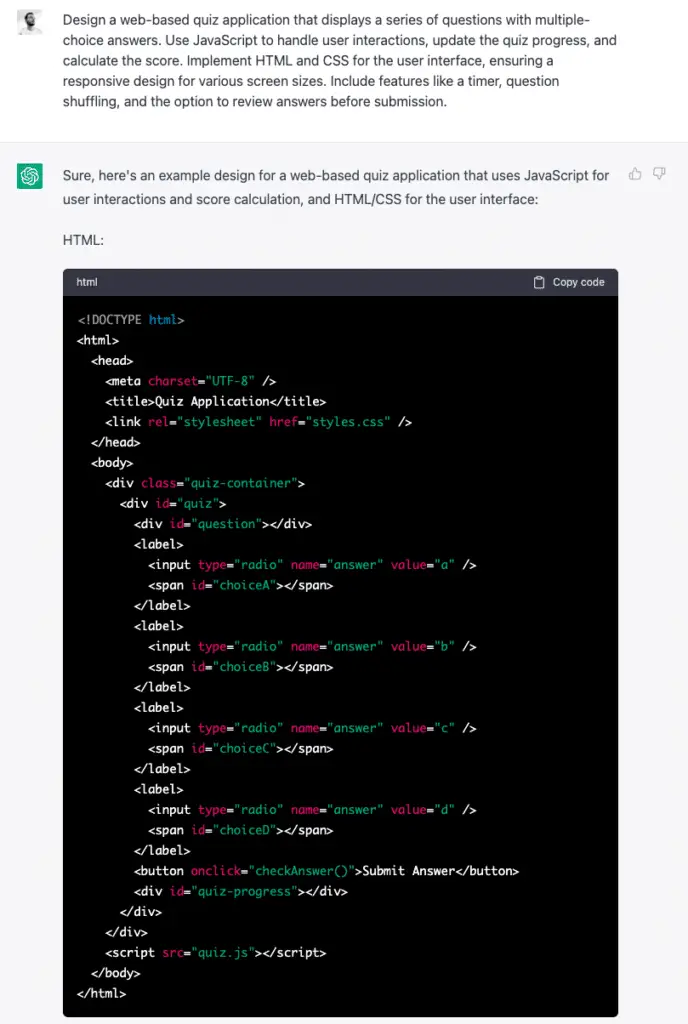
1. Design a web-based quiz application that displays a series of questions with multiple-choice answers. Use JavaScript to handle user interactions, update the quiz progress, and calculate the score. Implement HTML and CSS for the user interface, ensuring a responsive design for various screen sizes. Include features like a timer, question shuffling, and the option to review answers before submission.
2. Develop a to-do list application using JavaScript, HTML, and CSS that allows users to add, edit, and delete tasks. Incorporate local storage to save task data in the user’s browser, ensuring persistence across sessions. Implement a reminder feature that sends notifications when tasks are due or overdue, using the Notification API or a third-party library.
3. Develop a JavaScript-based interactive map application using a mapping library like Leaflet or OpenLayers. Implement features like geocoding, directions, points of interest, and custom map layers. Consider integrating real-time data sources, such as weather or traffic information, to enhance the user experience.
4. Create a JavaScript-based photo editing web application using libraries like Fabric.js or Konva.js for image manipulation. Implement features like cropping, resizing, filters, and text overlays. Allow users to upload images, edit them in the browser, and save the modified images in various formats.
5. Build a JavaScript-based real-time collaboration tool for document editing, similar to Google Docs. Implement features like text editing, formatting, and simultaneous multi-user editing with real-time updates. Utilize WebSockets or Firebase for real-time communication and data synchronization.
6. Design a JavaScript-based online code editor with syntax highlighting, auto-completion, and error checking for various programming languages. Utilize libraries like CodeMirror or Ace for the editor component and integrate APIs or language servers for language-specific features.
7. Develop a JavaScript-based browser extension that enhances the functionality of a specific website or service, such as adding new features, improving user experience, or automating repetitive tasks. Ensure the extension is compatible with popular browsers like Chrome, Firefox, and Edge.
8. Develop a JavaScript-based note-taking web application that allows users to create, edit, and delete rich-text notes. Implement features like autosave, categorization, and search functionality. Utilize local storage or a cloud-based solution like Firebase for data persistence.
9. Create an interactive data visualization web application using JavaScript and a library like D3.js or Chart.js. Allow users to input or upload datasets and generate customizable graphs, charts, and maps to visualize the data.
10. Build a JavaScript-based Kanban board application for managing tasks and projects. Implement features like drag-and-drop functionality, customizable columns, and task prioritization. Consider integrating a real-time collaboration feature using WebSockets or Firebase.
11. Design a JavaScript and WebGL-based 3D model viewer for showcasing product designs, architectural models, or other 3D assets on the web. Implement features like zoom, rotate, and pan, and allow users to customize the lighting and background settings.
12. Develop a progressive web application (PWA) for a news aggregator that fetches articles from multiple sources using APIs like News API. Implement features like offline reading, push notifications, and customizable news categories.
ChatGPT Prompts For Java Coders
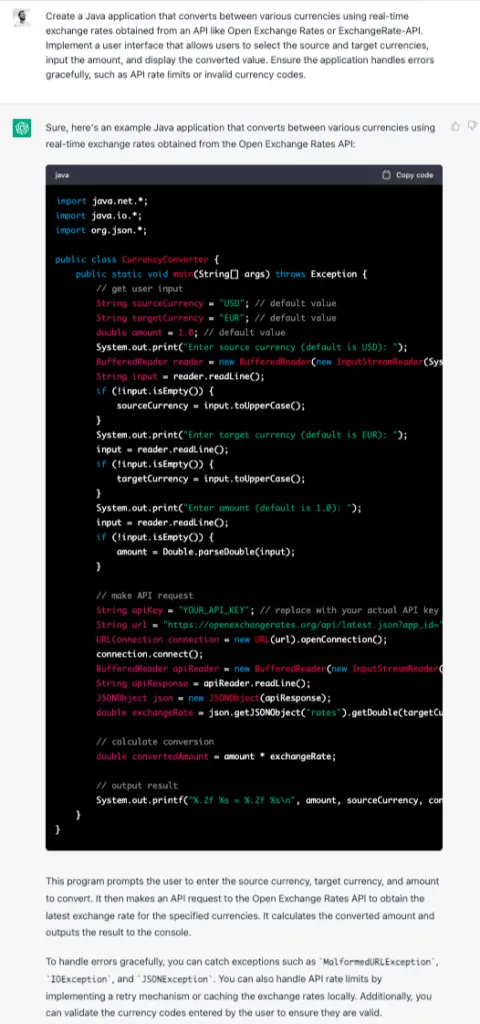
1. Create a Java application that converts between various currencies using real-time exchange rates obtained from an API like Open Exchange Rates or ExchangeRate-API. Implement a user interface that allows users to select the source and target currencies, input the amount, and display the converted value. Ensure the application handles errors gracefully, such as API rate limits or invalid currency codes.
2. Write a Java program that allows users to input their expenses, categorize them, and visualize their spending patterns over time. Implement features like budgeting, alerts for overspending, and customizable categories. Utilize a database or file system for data storage and retrieval, and incorporate graphical representations of data, such as pie charts or bar graphs, for easier analysis.
3. Create a Java-based desktop application for managing personal finance, such as tracking income and expenses, budgeting, and financial goal setting. Implement features like transaction categorization, recurring transactions, and financial reports. Utilize a database like SQLite for data storage and retrieval.
4. Develop a Java-based network scanner tool that identifies devices connected to a local network, retrieves device information, and checks for open ports or vulnerabilities. Implement features like IP range scanning, hostname resolution, and customizable scanning profiles.
5. Build a Java-based file encryption and decryption tool that supports various encryption algorithms, such as AES, RSA, or Blowfish. Implement features like key generation, file selection, and progress indicators. Ensure the application handles errors gracefully and provides a user-friendly interface.
6. Design a Java-based time-tracking application for freelancers or remote workers to track their work hours, projects, and tasks. Implement features like manual time entry, timer functionality, and reporting. Consider integrating third-party APIs for calendar syncing or invoicing.
7. Create a Java-based music player application with features like playlist management, metadata editing, and audio playback controls. Utilize libraries like JavaFX or Swing for the user interface and Java Sound API or JLayer for audio playback. Implement additional features like equalizers, visualizations, or online music streaming integration.
8. Create a Java-based chat application that supports real-time communication between users. Implement features like private messaging, group chats, and file sharing. Utilize technologies like Java sockets and multithreading for efficient communication.
9. Develop a Java-based document management system for organizing, storing, and retrieving digital documents. Implement features like full-text search, version control, and access control. Consider integrating Optical Character Recognition (OCR) functionality using a library like Tesseract to enable searching within scanned documents.
10. Build a Java-based file synchronization tool that keeps files and directories in sync across multiple devices or cloud storage services. Implement features like conflict resolution, file versioning, and selective syncing.
11. Design a Java-based point of sale (POS) system for retail businesses. Incorporate features like inventory management, sales tracking, payment processing, and customer relationship management. Utilize a database like MySQL for data storage and retrieval.
12. Create a Java-based server monitoring tool that tracks server performance metrics such as CPU usage, memory consumption, and disk space. Implement a graphical user interface using JavaFX or Swing, and provide alerts or notifications for critical performance issues.
ChatGPT Prompts For C++ Coders
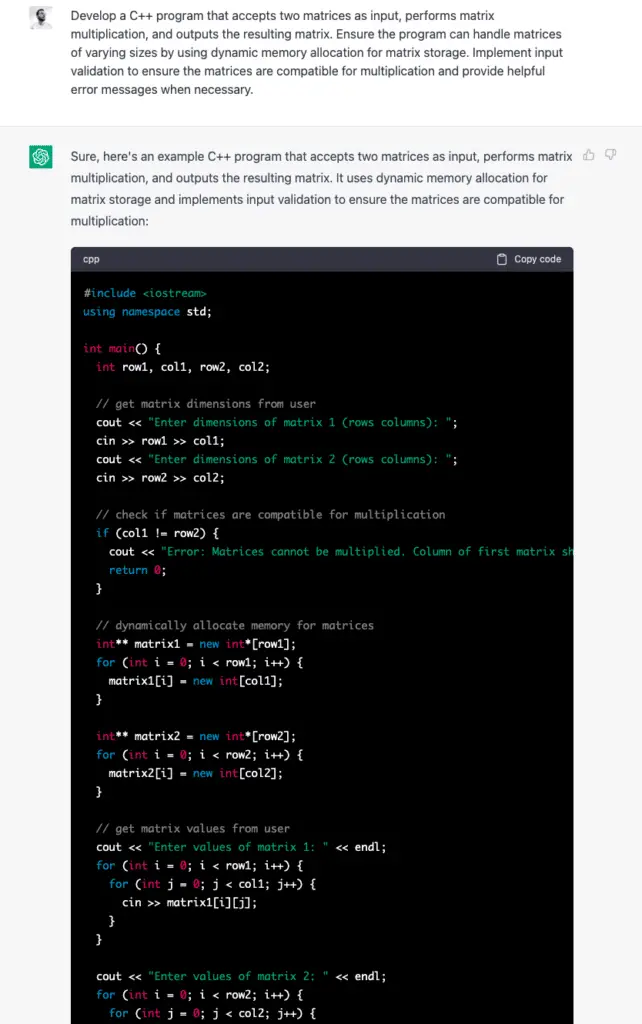
1. Develop a C++ program that accepts two matrices as input, performs matrix multiplication, and outputs the resulting matrix. Ensure the program can handle matrices of varying sizes by using dynamic memory allocation for matrix storage. Implement input validation to ensure the matrices are compatible for multiplication and provide helpful error messages when necessary.
2. Design a C++ program that simulates a basic traffic management system, incorporating features like traffic lights, road intersections, and vehicle movements. Use object-oriented programming principles to represent the different elements of the system and their interactions. Implement a simple user interface to visualize the simulation and allow users to control certain aspects, such as adjusting traffic light timings or adding new vehicles to the simulation.
3. Develop a C++ program for simulating and analyzing different sorting algorithms, such as Bubble Sort, Quick Sort, or Merge Sort. Implement visualization of the sorting process, display performance metrics like time complexity and comparisons, and allow users to customize the input data size and sorting algorithm.
4. Design a C++-based ray-tracing engine that renders 3D scenes with realistic lighting, shadows, and reflections. Utilize object-oriented programming principles to represent different scene elements and their interactions. Implement features like material properties, light sources, and camera controls.
5. Create a C++ program that simulates a simple artificial intelligence agent navigating a 2D grid-based environment. Implement pathfinding algorithms like A* or Dijkstra’s, and allow users to customize the grid size, obstacles, and agent starting and ending positions.
6. Develop a C++ program for solving complex mathematical problems, such as finding the roots of a polynomial, solving systems of linear equations, or performing matrix operations. Implement a user-friendly interface for inputting problems and displaying the results, and utilize libraries like Eigen or Boost for efficient mathematical operations.
7. Develop a C++ program that simulates a file compression algorithm, such as Huffman coding or Lempel-Ziv-Welch (LZW). Implement features like file compression, decompression, and performance analysis, including compression ratio and time taken. Ensure the program works with various file types and sizes.
8. Create a C++ implementation of a basic blockchain for educational purposes. Implement features like creating new blocks, validating the integrity of the chain, and mining new blocks using a proof-of-work algorithm. Consider adding a simple cryptocurrency functionality with transactions and wallet management.
9. Design a C++ program that simulates a simple computer network with nodes, routers, and data packets. Implement features like packet routing, congestion control, and network topology visualization. Utilize object-oriented programming principles to represent the different network elements and their interactions.
10. Develop a C++-based audio processing tool that can perform basic audio manipulation tasks, such as volume adjustment, equalization, and noise reduction. Utilize libraries like PortAudio or RtAudio for audio input and output, and consider integrating a command-line interface or a graphical user interface using Qt.
11. Create a C++ program that performs image processing tasks, such as resizing, filtering, and edge detection, using a library like OpenCV. Implement a user-friendly interface to load images, apply transformations, and save the modified images in various formats.
12. Build a C++-based video processing tool that can perform basic video editing tasks, such as cutting, resizing, or video format conversion. Utilize libraries like FFmpeg or OpenCV for video processing and consider creating a command-line interface or a graphical user interface using Qt.
ChatGPT Prompts For Ruby Coders
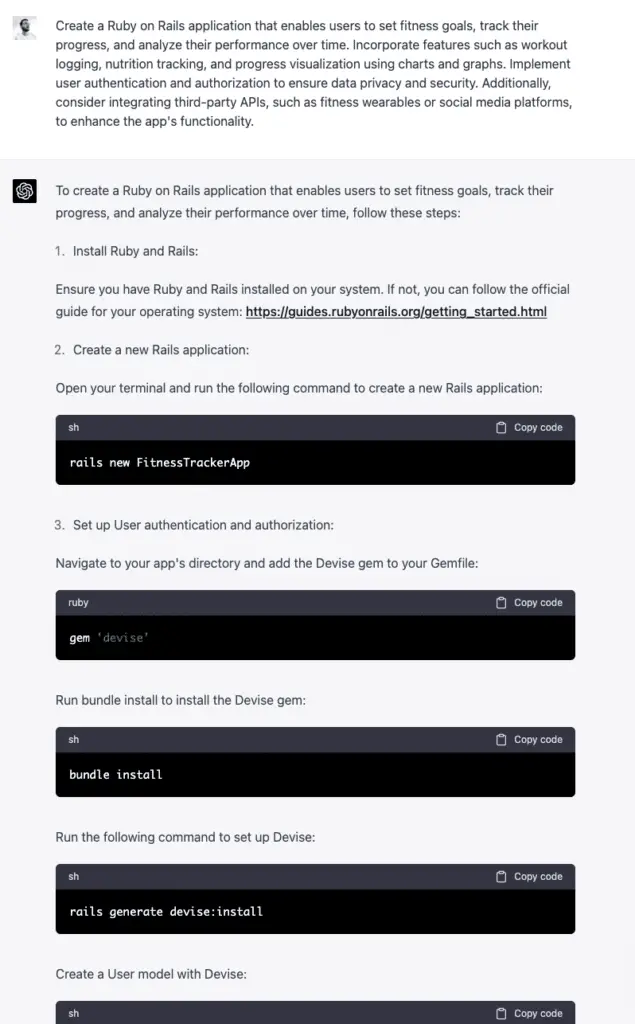
1. Create a Ruby on Rails application that enables users to set fitness goals, track their progress, and analyze their performance over time. Incorporate features such as workout logging, nutrition tracking, and progress visualization using charts and graphs. Implement user authentication and authorization to ensure data privacy and security. Additionally, consider integrating third-party APIs, such as fitness wearables or social media platforms, to enhance the app’s functionality.
2. Write a Ruby script that scans a specified directory for files and organizes them based on their file types, such as documents, images, or videos. Create subdirectories for each file category and move the corresponding files into their designated folders. Implement additional features, like deleting duplicate files, removing empty folders, and renaming files based on a customizable naming convention.
3. Create a Ruby on Rails web application for a crowdfunding platform that allows users to create, fund, and manage crowdfunding campaigns. Implement features like project creation, funding goals, rewards, and updates. Integrate payment processing using third-party APIs like Stripe or PayPal.
4. Develop a Ruby-based command-line tool for batch processing and editing large text files, such as log files or data dumps. Implement features like search and replace, filtering, and sorting. Utilize Ruby’s built-in regular expressions and file-handling capabilities for efficient text processing.
5. Build a Ruby on Rails web application for a content management system (CMS) that allows users to create, edit, and manage blog posts or articles. Implement features like rich-text editing, media management, and content categorization. Consider integrating SEO best practices and social media sharing capabilities.
6. Design a Ruby-based web scraper that extracts data from websites and stores the extracted data in a structured format like CSV, JSON, or XML. Implement features like customizable extraction patterns, error handling, and rate-limiting. Utilize libraries like Nokogiri for HTML parsing and HTTParty for web requests.
7. Create a Ruby on Rails web application for a file-sharing platform that allows users to upload, download, and share files securely. Implement features like user authentication, file encryption, and access control. Utilize cloud-based storage solutions like AWS S3 or Google Cloud Storage for file hosting.
8. Develop a Ruby on Rails web application for a job board that allows users to post job openings, search for jobs, and submit applications. Implement features like user authentication, job bookmarking, and employer dashboards for managing job postings and reviewing applications.
9. Create a Ruby script that monitors cryptocurrency prices using an API like CoinGecko or CoinMarketCap. Implement features like real-time price tracking, historical price data analysis, and customizable alerts for specific price changes or trends.
10. Build a Ruby on Rails web application for organizing and managing events, such as conferences, workshops, or meetups. Incorporate features like event creation, attendee registration, ticketing, and schedule management. Consider integrating third-party APIs for calendar syncing or payment processing.
11. Design a Ruby-based command-line tool for managing and deploying cloud infrastructure using Infrastructure as Code (IaC) principles. Utilize a cloud provider’s API, such as AWS, Google Cloud, or Azure, to create, modify, and delete resources based on user-defined configuration files.
12. Develop a Ruby on Rails web application for a restaurant reservation system. Implement features like table management, reservation scheduling, and customer notifications. Incorporate user authentication and role-based access control to differentiate between restaurant staff and customers.
8 Examples of Long-Form ChatGPT Coding Prompts for Various Languages
Python:
- Build a random password generator.
- Create a script to rename multiple files.
- Develop a web scraper for extracting quotes.
- Implement a simple file encryption tool.
- Design a currency converter using an API.
- Build a command-line quiz game.
- Create a script to download images from a URL.
- Develop a Pomodoro timer application.
JavaScript:
- Design a responsive navigation menu.
- Build a simple image carousel.
- Implement a to-do list web application.
- Create a custom context menu.
- Develop a dynamic content filter for lists.
- Build an analogue clock using Canvas API.
- Design a web-based stopwatch.
- Implement a typing speed test.
Java:
- Build a simple file search utility.
- Design a currency converter using an API.
- Implement a command-line calculator.
- Develop a basic Sudoku solver.
- Create a system tray application.
- Build a simple chatbot.
- Implement a tic-tac-toe game.
- Design a web server using sockets.
C++:
- Build a command-line number-guessing game.
- Design a simple file copy utility.
- Implement a Caesar cypher encoder/decoder.
- Develop a palindrome checker.
- Create a program to compute the factorial of a number.
- Build a simple array sorting utility.
- Implement a program to find prime numbers.
- Design a basic command-line text editor.
Ruby:
- Build a URL shortener script.
- Design a command-line weather app.
- Implement a simple web server.
- Develop a program to parse CSV files.
- Create a script to monitor file changes.
- Build a command-line tool to find duplicate files.
- Implement a program to generate QR codes.
- Design a simple text-based game.
How Coders and Developers Can Benefit from ChatGPT Coding Prompts?
- Improve problem-solving skills: Tackling diverse coding prompts helps developers sharpen their problem-solving abilities and critical thinking.
- Enhance programming language proficiency: By working on prompts specific to a particular language, coders can gain a deeper understanding of language-specific concepts and syntax.
- Expand software development portfolios: Completing coding prompts allows developers to showcase their expertise through a diverse range of projects, attracting potential employers or clients.
- Foster creativity and innovation: Exploring various coding prompts encourages developers to think outside the box and come up with unique solutions.
- Stay up-to-date with industry trends and best practices: Regularly practising coding prompts helps developers stay informed about the latest technologies and techniques in software development.
Best Practices for Using ChatGPT Coding Prompts
- Start with the basics and gradually increase complexity: Choose prompts that align with your skill level and gradually work on more complex projects as your expertise grows.
- Collaborate with peers to exchange ideas and solutions: Engage with fellow developers to discuss approaches, learn from each other, and receive feedback.
- Customize prompts to align with personal interests and goals: Tailor prompts to focus on areas you’re passionate about or wish to improve upon.
- Seek feedback from experienced developers or online communities: Share your solutions with experts or online forums to gather valuable insights and recommendations for improvement.
- Implement version control and follow coding standards: Use version control systems like Git to track changes and adhere to industry-standard coding practices for better maintainability.
coding prompts offer an incredible opportunity for developers to improve their skills, expand their knowledge, and stay competitive in the industry. By regularly tackling diverse prompts, coders can refine their problem-solving abilities, gain proficiency in various programming languages, and build an impressive development portfolio. Remember to follow best practices, collaborate with peers, and seek feedback to ensure continuous growth and improvement.
At GPTPromptsHub, our team is committed to providing high-quality, authentic, and helpful content to support the developer community. Stay tuned for more blog posts that explore various use cases of ChatGPT and other programming-related topics.
Happy coding!
Frequently Asked Questions (FAQs) on ChatGPT Coding Prompts
What are the key benefits of using ChatGPT coding prompts?
ChatGPT coding prompts help to improve problem-solving skills, enhance programming language proficiency, expand software development portfolios, foster creativity, and stay up-to-date with industry trends.
How can I choose the right coding prompt for my skill level?
Start with prompts that match your current skills and gradually progress to more complex projects as you become more confident.
Can I use these prompts to learn a new programming language?
Yes, working on coding prompts in a new language is an excellent way to familiarize yourself with the language’s syntax and concepts.
How often should I practice with coding prompts?
Regular practice is essential for skill improvement. Aim to complete at least one or two coding prompts per week to maintain progress.
Are there any resources or tools to help me with ChatGPT coding prompts?
Online resources like Stack Overflow, GitHub, and programming language-specific forums can provide helpful insights and assistance with coding prompts.


